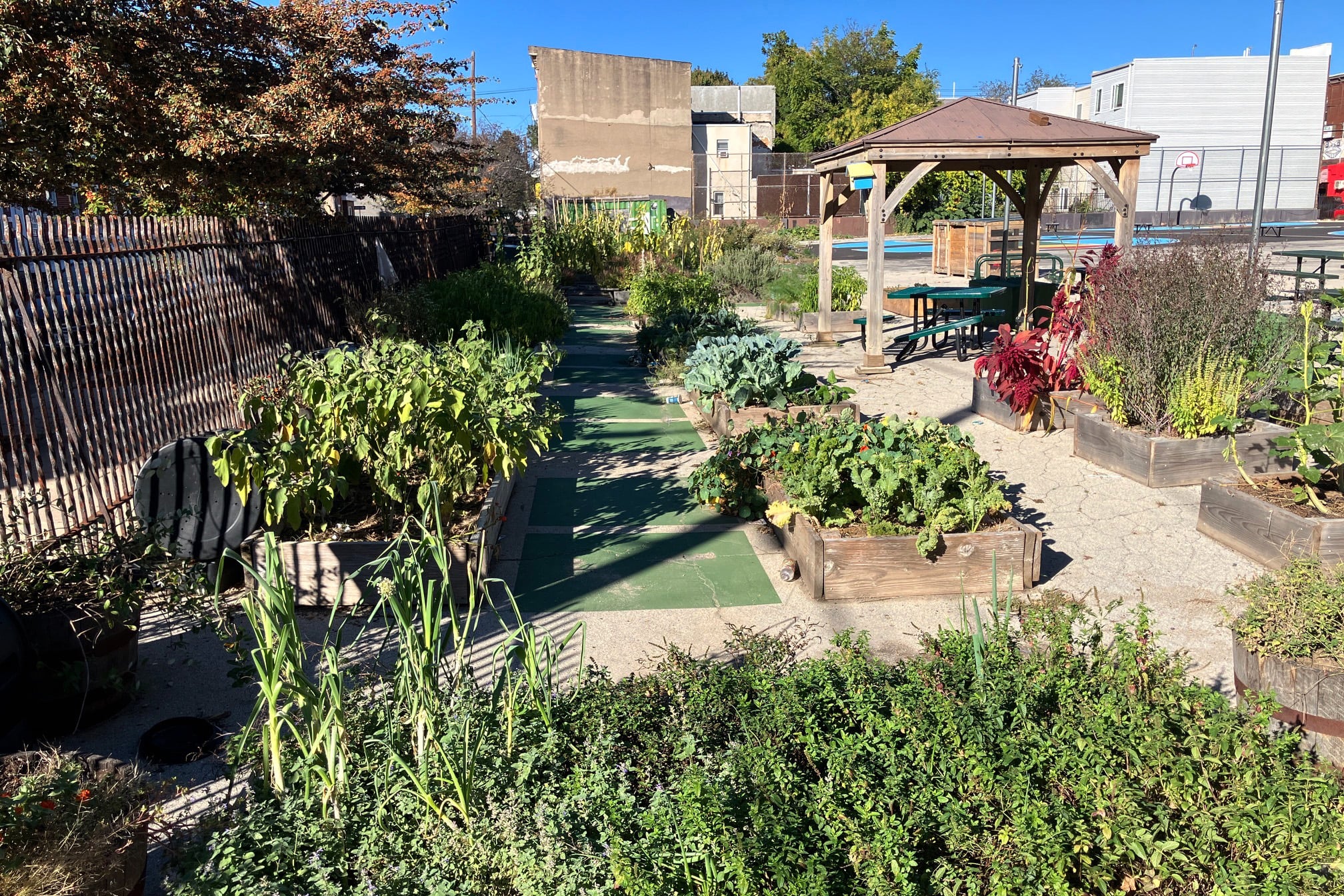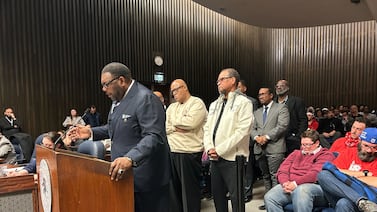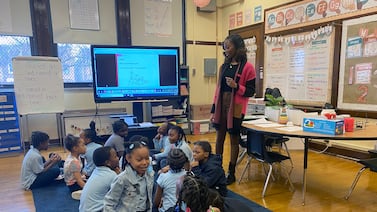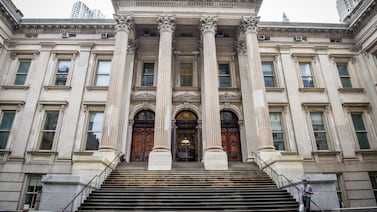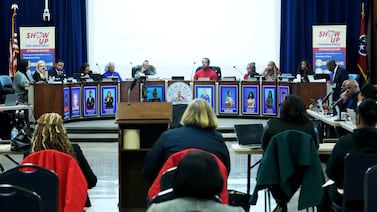Sign up for Chalkbeat Philadelphia’s free newsletter to keep up with news on the city’s public school system.
High school educator Anna Herman is a self-described “food person.” But her interests and expertise extend well beyond the plate.
As an urban agriculture, food, and natural resources teacher at The U School in North Philadelphia, Herman asks her students to research soil health and study the connection between the land, water, and the sociopolitical systems that contribute to their lives and diets.
“It’s about understanding the cycles of nature. It’s about understanding how to have access to more fresh, healthy food,” Herman said. “We’re trying to give kids exposure to things and then tangible career pathways within those things, so that there’s a sustainability throughline within that work.”
This year, Herman was selected to create a new curriculum unit through Yale University’s National Initiative program, which pairs public school educators with Yale faculty to “strengthen teachers’ content knowledge,” according to the program description.
Herman’s unit is called “Mapping the Future.” It combines analog and digital resources — think clay and paper as well as drones and Geographic Information Systems software — to map everything from Philadelphia’s topography to the indigenous histories of the Lenape people as they navigated displacement and environmental changes.
Herman wants her students to “excavate stories” about our land and geography and understand “the connections between how food grows, how energy is used in the food system, and how food companies use cognitive science to sell you ultra high processed foods” among other issues.
This interview has been edited for length and clarity.
How and when did you decide to become a teacher?
Before this, I ran an out-of-school time urban agriculture entrepreneurship program at Awbury Arboretum called Teen Leadership Corps. I was doing that, and I was an urban garden educator at Penn State Extension. I ran the Master Gardener program for six years. And before that, I was in the industry. I was a food business consultant and entrepreneur. I was a chef, and a caterer, and I worked in restaurants.
I didn’t go to graduate school, I saved up a chunk of money and I traveled. What I learned when I traveled is that every culture that has great cuisine, it’s really about the connection between the crops that are grown, or the cheese that they make, the wine — whatever it is, it’s very much place-based. So I became interested in gardening from that. I was always a food person. I became a garden person and a garden educator because I wanted good ingredients.
I didn’t quite understand those connections initially, that good cooking comes from good ingredients, good ingredients comes from good farms. Good farms come from good soil. Good soil comes from taking care of the cycles [of nature] so I became an environmentalist, sort of through the back door of food. And then I really became an environmental educator probably when I had kids.
This is my capstone career. I came to teaching in my late 50s with a lot of experience in food, agriculture, and natural resources and so this program was a natural thing for me.
What does your work look like in a classroom setting?
We do a boatload of food growing indoors and out. We do some food processing, we do a lot of field trips and work with partners. Our major focus is green career exploration. So it’s thinking about whatever interest you have, there is some way of thinking about that in a more sustainable way. If you’re interested in construction, it’s understanding the material supply chain in the construction field. It’s understanding energy. We do a lot of trips, we have a lot of really fantastic partners who take kids out in the field.
In our classroom, we’re telling sustainability stories around Philadelphia, place-based stories using tools from National Geographic’s 2892 Miles To Go education program, like these powerful GIS tools that [students] could use to do place-based storytelling projects. … We had all these resources. We had all these workshops. It was a really fantastic experience.
I realized one of the things that was missing for me and for [students] was a deeper understanding of how to use how to use maps, how maps can be part of the storytelling, but also how they can help you understand the environment, how they can help you understand history, how they can help you tell stories, and how they can help you learn content.
And how does that tie into your ‘Mapping the Future’ unit?
This mapping unit very much starts with what this geographic area was like before humans. It imagines ecological time. And then it goes into what it looked like when the Lenni Lenape were here. And you can see the neighborhoods, you can see Wingohocking [Creek]. You can see Manayunk, which meant ‘the place where we drink,’ and this is the place where we got clams, and all these names that kids will recognize. And then we use 3D printing to make the shape of Philadelphia.
I have a lot of hands-on opportunities to learn the shape and the geography and the geology of Philly, and then how it specifically relates to watershed issues, environmental issues, where were factories located in the ’50s that now are creating lead issues in the soil? Where’s the water flowing from here to there?
One of our partners brought in a map, literally the size of our gym, that the kids could walk around on and look at the river. They could walk from Schuylkill County down to Philadelphia. And then in Philadelphia to see where the water actually flows.
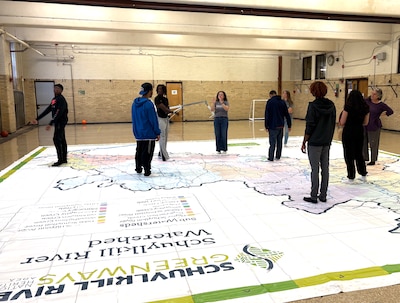
Students don’t quite understand that we drink the river. If we throw our trash in the street, it ends up in the drinking water, and we have to pay to clean it up. And so we’re trying to make all these very tangible connections in a place-based way.
We’re trying to combine data collection, data visualization, with how you communicate about issues, and how you advocate for things.
How do challenges going on in Philly communities impact your lesson planning?
Every year I poll students and have a process for excavating what things matter to them. It’s almost always gun violence, the opioid crisis, and trash. Those are the three things that they notice that they really want to change.
Our first unit of the year is very much about viewing the city through the lens of those issues. It turns out there’s a lot of really interesting research about how greening and cleaning impacts gun violence and various public health measures.
They find that out for themselves, and then they are very excited to actually [act on it] they’re like, ‘oh miss, we should go out and clean the yard, because people have been throwing stuff around.’ I’m like, ‘that’s a great idea. There’s 12 brooms and four pairs of gloves over there. Go ahead.’ The idea is for them to come up with these solutions.
I have a huge back burner of ideas and projects that we could work on and whatever things kids in this particular cohort are interested in we pull up for the front burner.
What’s something you’ve read that’s made you a better educator?
“The Omnivore’s Dilemma” and “Braiding Sweetgrass” were two books that really were influential in terms of reminding myself how connected everything is and how important it all is.
I am a big reader, and I think that speculative fiction, sort of imagining the future and imagining this place in the future—you can’t push towards change without having an idea of what the future is going to be like. I do a lot with the “Parable of the Sower” and “Parable of the Talents” [by Octavia E. Butler].
Ezra Klein’s new book called “Abundance” is also pretty special. Just in terms of the political realities.
In a couple of my units I do flash fiction and ask students to just quick-write: What do you imagine it would be like if we don’t make changes? And if we do make changes? Imagine from the perspective of a kid waking up in North Philly looking out the window, what do they see? What do they smell?
Carly Sitrin is the bureau chief for Chalkbeat Philadelphia. Contact Carly at csitrin@chalkbeat.org.

